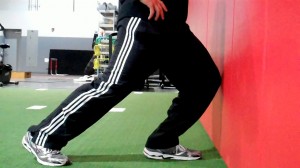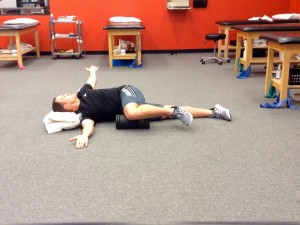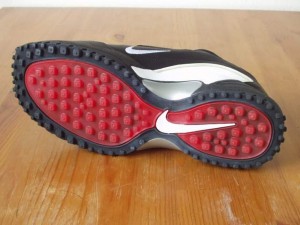Brian Schiff’s Blog
Injury Prevention, Sports Rehab & Performance Training Expert
This post is dedicated to improving mobility in two areas I commonly find restrictions in among my clients – the ankle and thoracic spine. Specifically, I often find limitations in dorsiflexion and thoracic spine rotation that create undue stress on other parts of the kinetic chain.

Standing wall touch
Recently, I wrote an article for the WeckMethod site on how to assess and improve ankle mobility. As a clinician and coach, I see this issue in many runners and athletes I work with. At times, it is joint restriction, while in other cases it is soft tissue limitations that impact mobility.
There are several potential reasons why one might possess less than optimal movement in the ankle. The most common causes include: joint stiffness following injury and/or immobilization, soft tissue tightness in the gastroc/soleus complex, scar tissue from a prior injury, anterior ankle impingement, chronic ankle instability and adaptive shortening of the Achilles tendon. Want to read more?
Click here to read my article on the WeckMethod site
Decreased mobility in the thoracic spine often creates dysfunction and stress on other parts of the kinetic chain, namely the shoulder and lumbar spine. In many cases, clients will demonstrate asymmetry based on their sport, activity level and injury history. In light of this, I often prescribe a simple, yet effective corrective exercise they can do at home to restore motion. The exercise below is taken from my ‘Functionally Fit’ column I recently did for PFP Magazine.

Side lying t-spine roll
In the full online column, I reveal two ways to do this and the applications for it. This exercise also offers a way to assess your own range of motion, while teaching you a straightforward corrective exercise to improve mobility.
Facilitating better lower leg stability is always a priority in my rehab and training programs. I have long been an advocate of single leg training to resolve asymmetry and reduce compensations and injury risk. Once a client masters form on the ground, adding in more proprioceptive challenges can take their training to a new level.
Today I wanted to share a previously unpublished video I shot for my ‘Functionally Fit’ column that demonstrates a single leg squat exercise on the BOSU Elite Trainer. It is a relatively new exercise tool that offers some tweaks on the original BOSU balance trainer.
Every year I like to look back and reflect on things I have learned, things I have changed my mind about and of course clinical pearls that stand out. Over the past year, I have been sharpening my IASTM skills, begun to practice dry needling techniques, and scrutinizing my hip and core exercises that I routinely use in rehab.
I look forward to sharing more about my clinical experiences with dry needling in 2014, but I feel the most critical and recurring theme of 2013 has been the overwhelming impact I have seen poor ankle dorsiflexion have on my patients. I treat scores or runners, triathletes and clients with knee pain. The most common issues in this group of clientele tends to be IT band friction syndrome or patellofemoral pain.
When I assess this group of patients, I routinely find the following:
- Poor dorsiflexion
- TFL dominance
- Glute weakness
Any time I evaluate a runner, I assess closed chain dorsiflexion (DF) mobility. This can be assessed in half kneeling on the floor or standing at a wall. I suggest removing the shoes during the assessment to eliminate any rise from the heel in the shoe that may bias the movement. In addition, I hold the ankle in subtalar neutral to get a true assessment without allowing pronation.
The image below simply demonstrates the assessment position as well as the corrective exercise that can be used to facilitate better motion.

Clients should be able to attain about 5 inches of clearance beyond the toes without lifting the heel or relying on pronation to get there. I routinely see limited mobility, and more importantly almost 100% of the time I find asymmetry on the side of the affected knee.
I recently evaluated a 29 y/o active female client who does Crossfit 3x/week and likes to run. She has not been running much due to chronic right lateral knee pain and medial calf pain. Her goal is to get back to running half-marathons. Upon evaluation, her overhead squat assessment revealed pronation and external rotation bilaterally, right greater then left. Her standing wall DF assessment revealed nearly a 1 inch deficit on the right side (about 3 inches), while her left side was 4 inches.
Below is how she looked on the treadmill video analysis I performed:

You can see the highlighted areas in the photo above. She has a marked amount of pronation in mid stance as well as left pelvic drop due to poor gluteal activation. The poor hip stability and activation on the right side also plays directly into TFL dominance with the repetitive femoral internal rotation and adducted position of her right hip..
This poor biomechanical chain is set into motion by poor dorsiflexion mobility. Runners can get away with this for shorter distances (3-4 miles) in many cases, but increased mileage leads to shin splints, calf strains, IT friction syndrome and patellofemroal pain. You can see how this poor kinetic chain movement leads to ongoing microtrauma and eventually debilitating pain and dysfunction. No matter how much one rests, going back to higher mileage will yield the same result.
In my client’s case, she also had a trigger point in her medial soleus – another issue connected with the ankle mobility problem. Her primary treatment plan will focus on soft tissue mobilization for the gastroc/soleus complex, TFL/ITB and glutes/piriformis, ankle dorsiflexion mobility exercises, IASTM to her gastroc/soleus/Achilles, single leg balance and strengthening and hip/core activation and stability work.
I am confident all of this will effectively resolve her pain. However, it all begins with restoring ankle mobility. They say a picture is worth a thousand words. I strongly believe the picture I included of my client on the treadmill speaks volumes as to how poor ankle mobility can lead to unwanted compensatory motion, gluteal inhibition and overuse injuries. The take home message here is be sure to assess ankle mobility in the presence of any lower extremity pain or dysfunction as it is often a critical piece of the puzzle in the face or recurring injury and chronic pain.
Often, people assume hip and knee pain begin and end in those respective joints. While this can be the case, the truth is the ankle may also have a say in the matter. In my practice, I often see gait deviations, IT band issues, patellofemoral pain and many other issues related to ankle stiffness or soleus issues.
In assessing athletes, runners and weekend warriors, I often pick up asymmetries when measuring closed chain ankle dorsiflexion. I have even observed people who have active dorsiflexion within normal limits while seated on a treatment table, but once they become weight bearing things change. Even small differences can dramatically affect the body as the brain will find a way to get the motion it needs to squat, run, lunge, etc.
This often involves a compensatory pattern at the knee and/or hip joint. So, to that end, I recommend several strategies to improve mobility. I am currently doing a three part series on this for PFP magazine to provide some effective exercises to improve ankle and soleus mobility. Click here to read the latest column.
Below is a sample video of the wall touches I use to improve ankle motion after mobilizing the soft tissue.
Typically, I advocate doing 1-2 sets 10-15 repetitions. Using the wall allows clients to have tactile feedback and a target to focus on. This is a simple, yet effective way to gain motion in a loaded closed chain fashion as the hip, knee and ankle flex together in running, landing, squatting, lunging, etc.
If you are curious how I assess side-to-side differences, click here to read my initial column on assessment. I hope these tools enhance your training and/or those you work with.
It has been known for years that increased coefficient of traction can predispose the knee to catastrophic injury. Hence, the reason we got rid of all the old style astro turf in football stadiums. But, traction is influenced by the sole architecture of the shoes as well as the playing surface. Unfortunately, we are not fully aware of how exactly the sole architecture or this increased traction can lead to injury.

Nike Astro Turf Shoe
Does footwear really matter? I say YES. Case in point – I am not a big fan of Nike Shox because they position the ankle in a plantar flexed position, thereby making it so much easier for ankles to roll inward with cutting. I have seen too many female athletes suffer inversion sprains while running suicides or training in these shoes. I simply believe the design creates a biomechanical mismatch and elevated risk for ankle sprains.
Now what about traction? A study in the American Journal of Sports Medicine by J Wannop et al. recently looked at the difference between two shoe designs in a controlled laboratory study. The tread types of shoes used were either smooth or tread.
The shoe used in the study was the adidas Response 2+ CPT (smooth shoe) and adidas Response=2(A) (tread shoe). The traction testing was performed using a robotic testing machine, while the researchers also observed 13 recreational athletes performing 45 degree V cuts in both shoes. Data was collected using 8 high speed cameras and a force plate.
The results are not shocking. The highlights are:
- The coefficient of translational traction and peak moment of rotation were both significantly higher in the tread show compared to the smooth shoe.
- In addition, the high-traction shoe had much higher peak ankle externalrotation moments, peak knee external rotation moments, peak knee adduction moments, and knee adduction angular impulse compared to low-traction shoe.
The findings of the study indicate that the resultant joint loading increased 12% in the ankle (transverse plane) and 13% and 20% in the transverse and frontal planes for the knee. This increased traction is certainly enough to push the knee into the previously reported mechanical rupture zone.
What we cannot deduce is whether the increases in joint loading is strictly attributable to the higher linear and rotational traction or if there is even a linear relationship between them at all.
You should also note that athletes often choose traction shoes for enhanced performance. In this study, there was no significant difference in the performance measured between the two groups. So, we are left to ponder whether we really need higher traction shoes at all. Future studies will need to address this relationship as preventing knee and ankle injuries just by adjusting footwear seems like a no-brainer if the science supports this.

